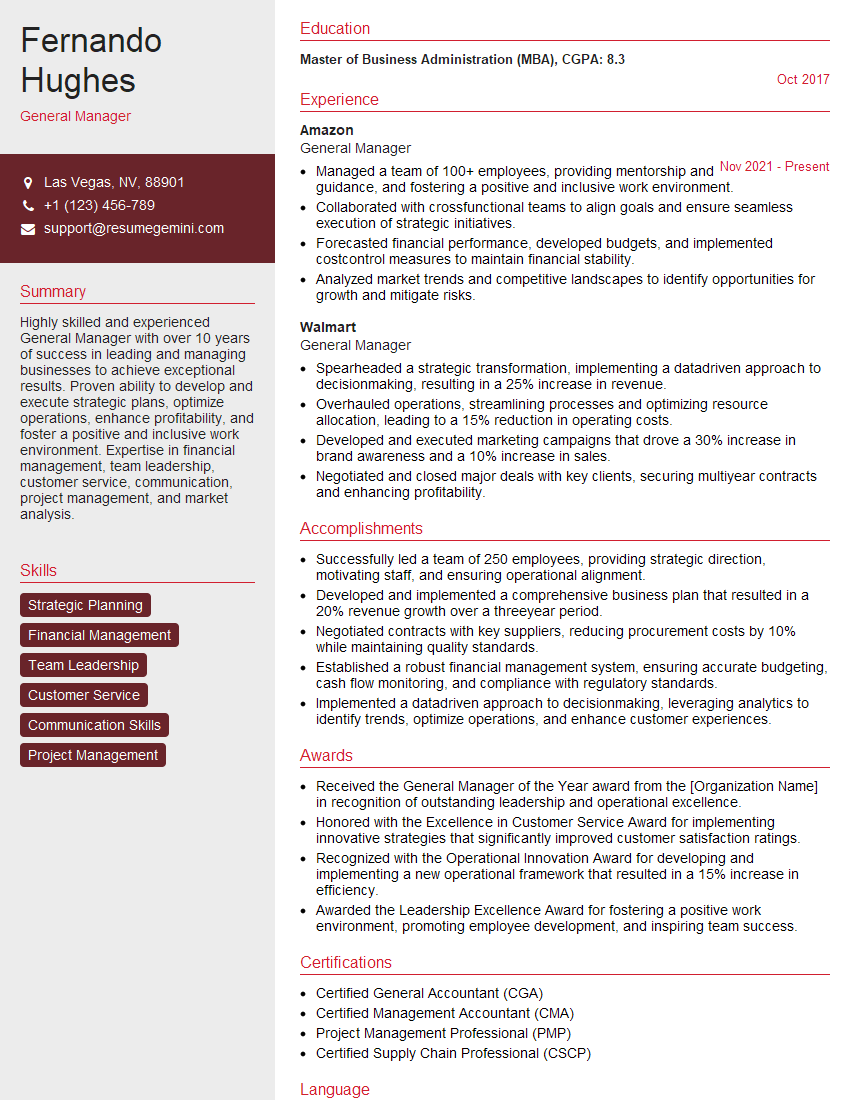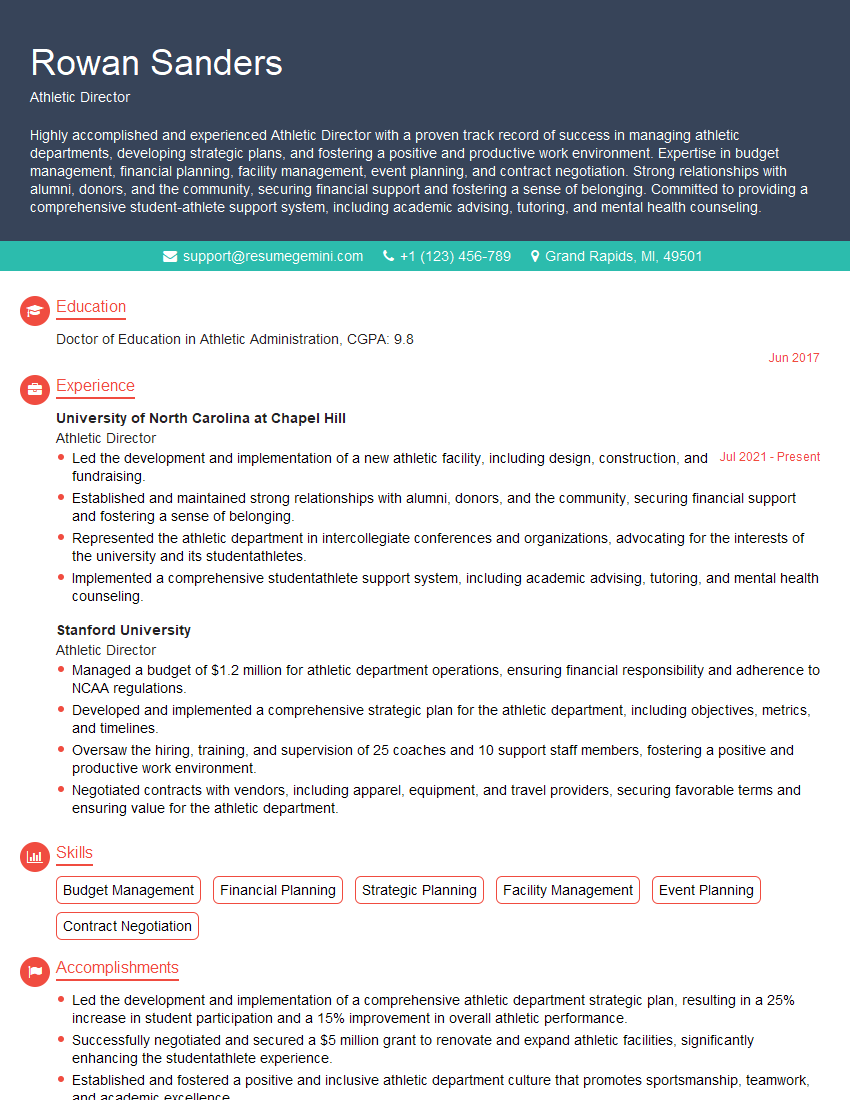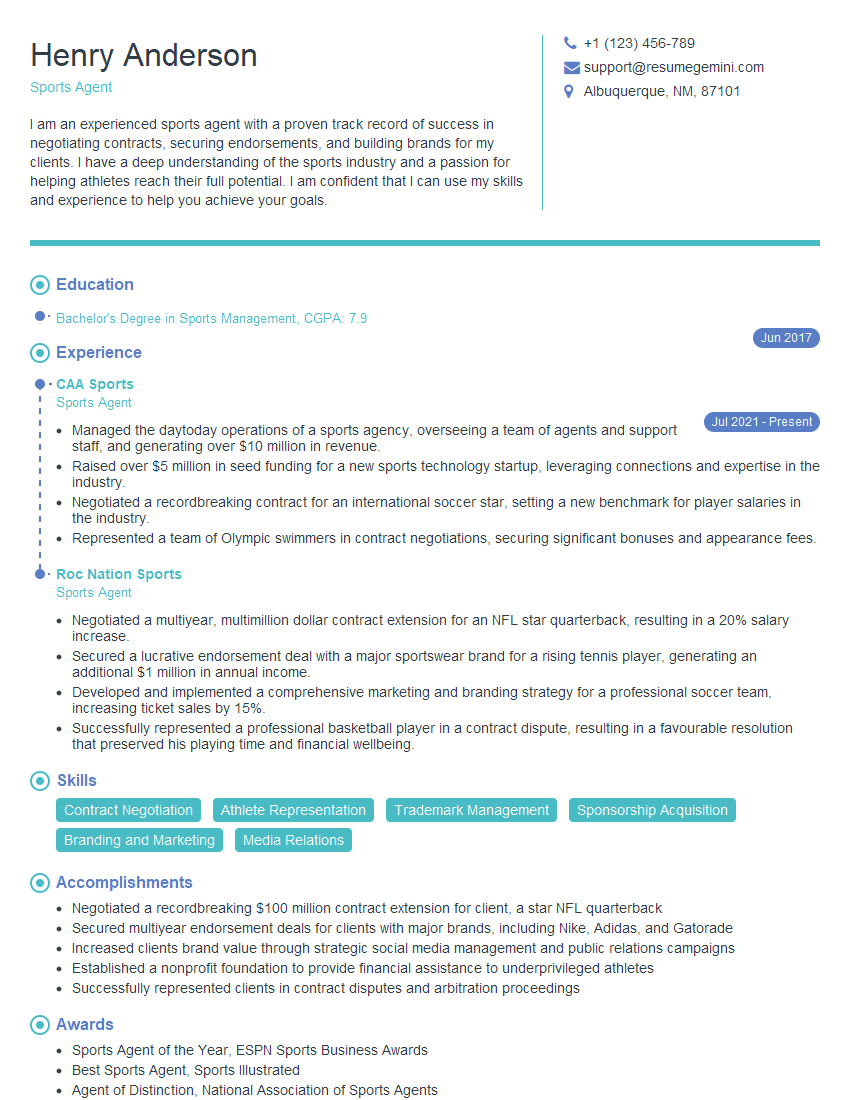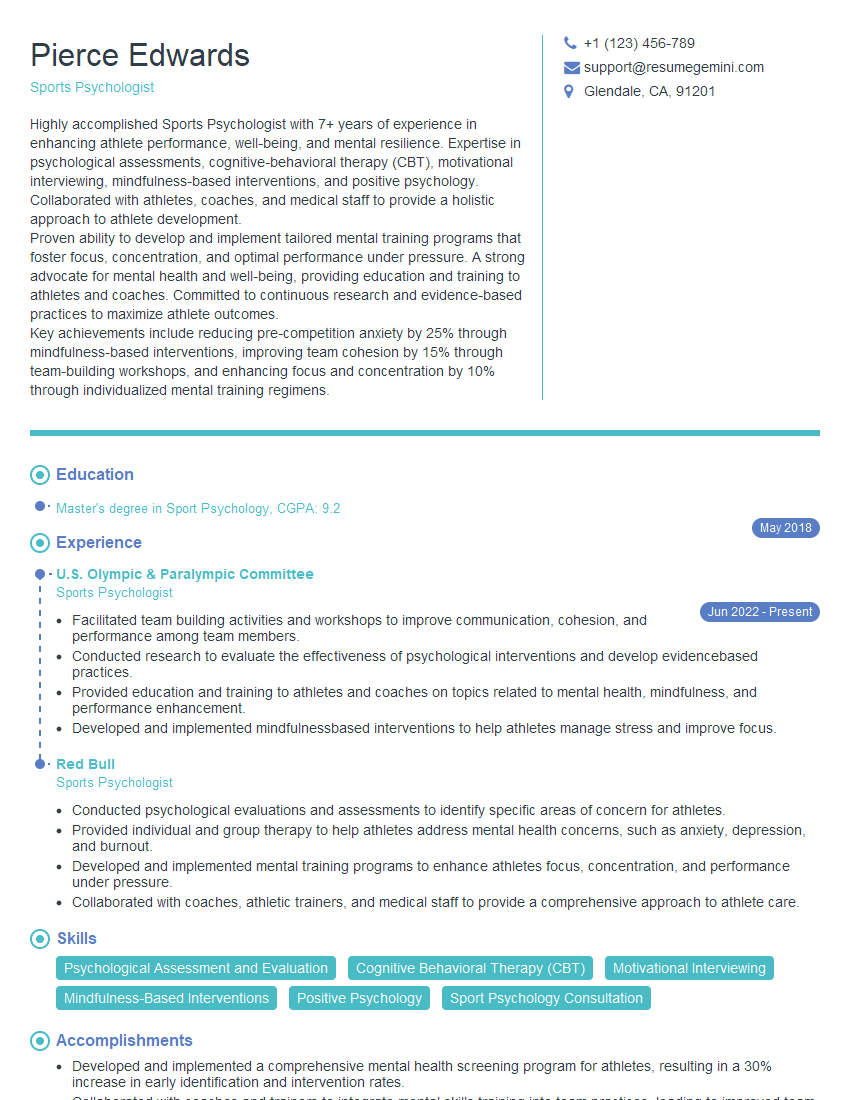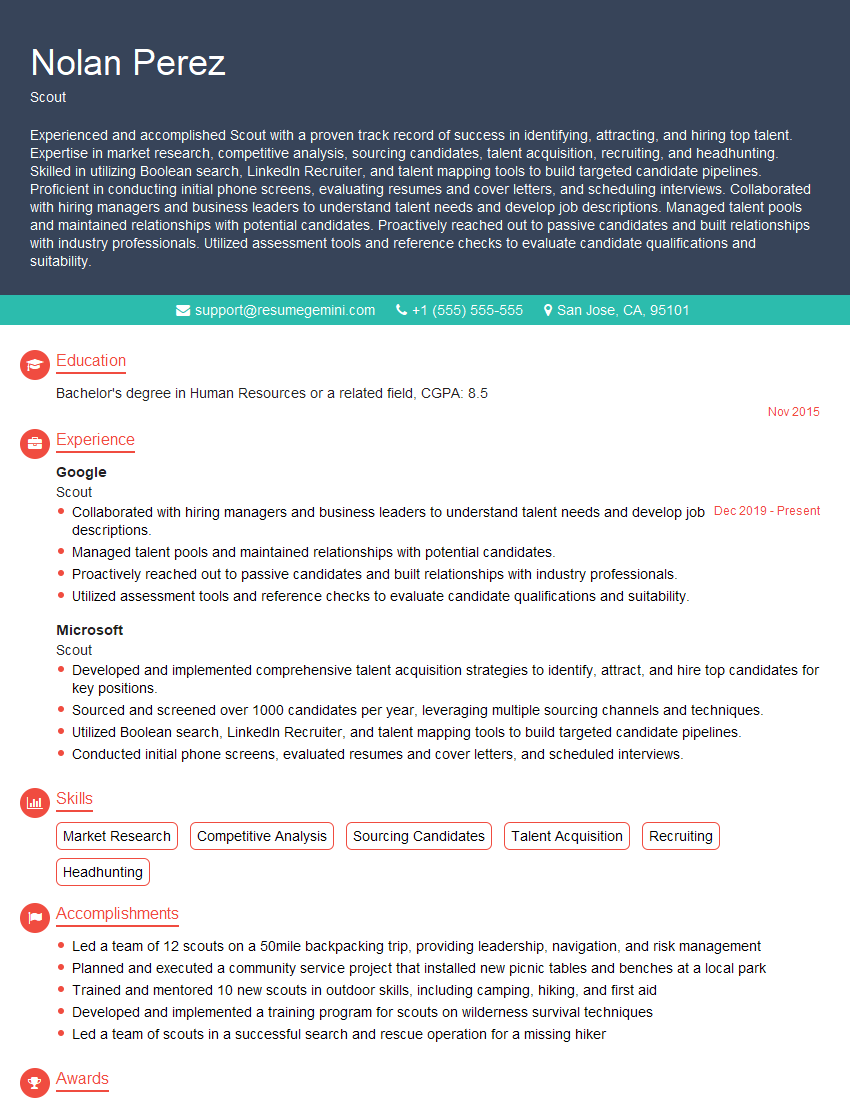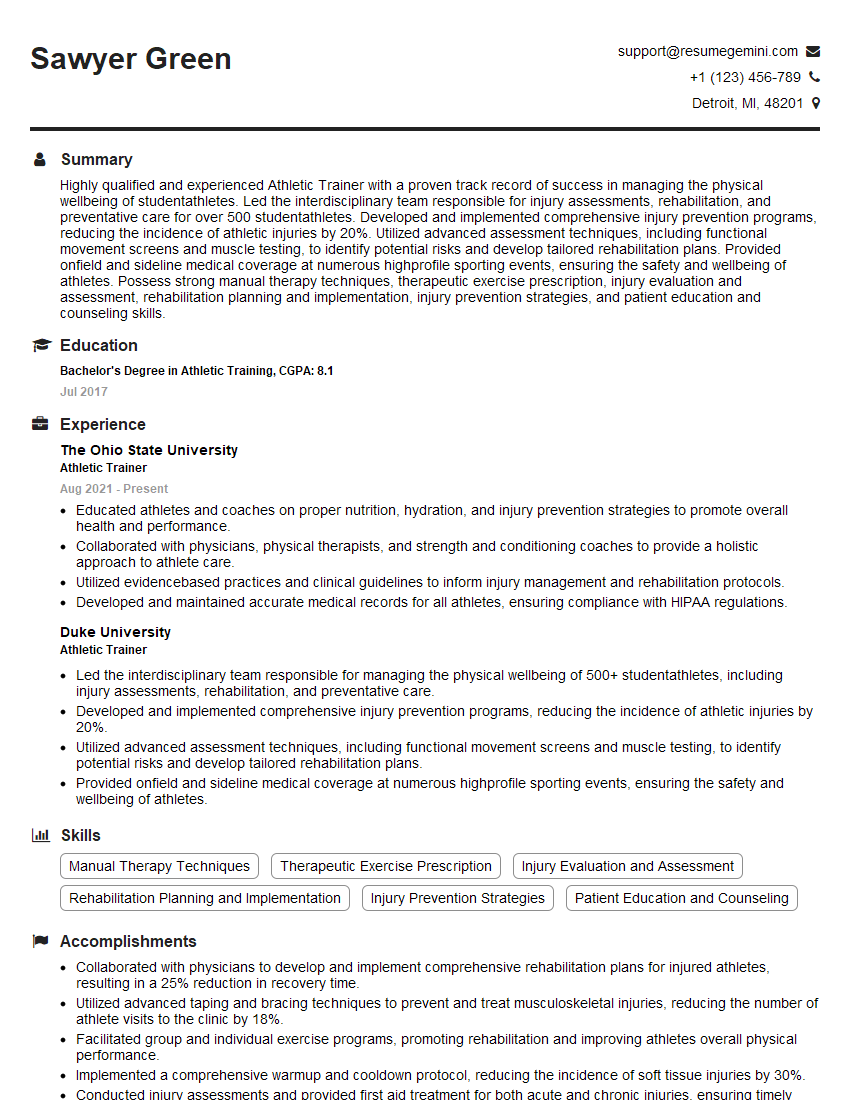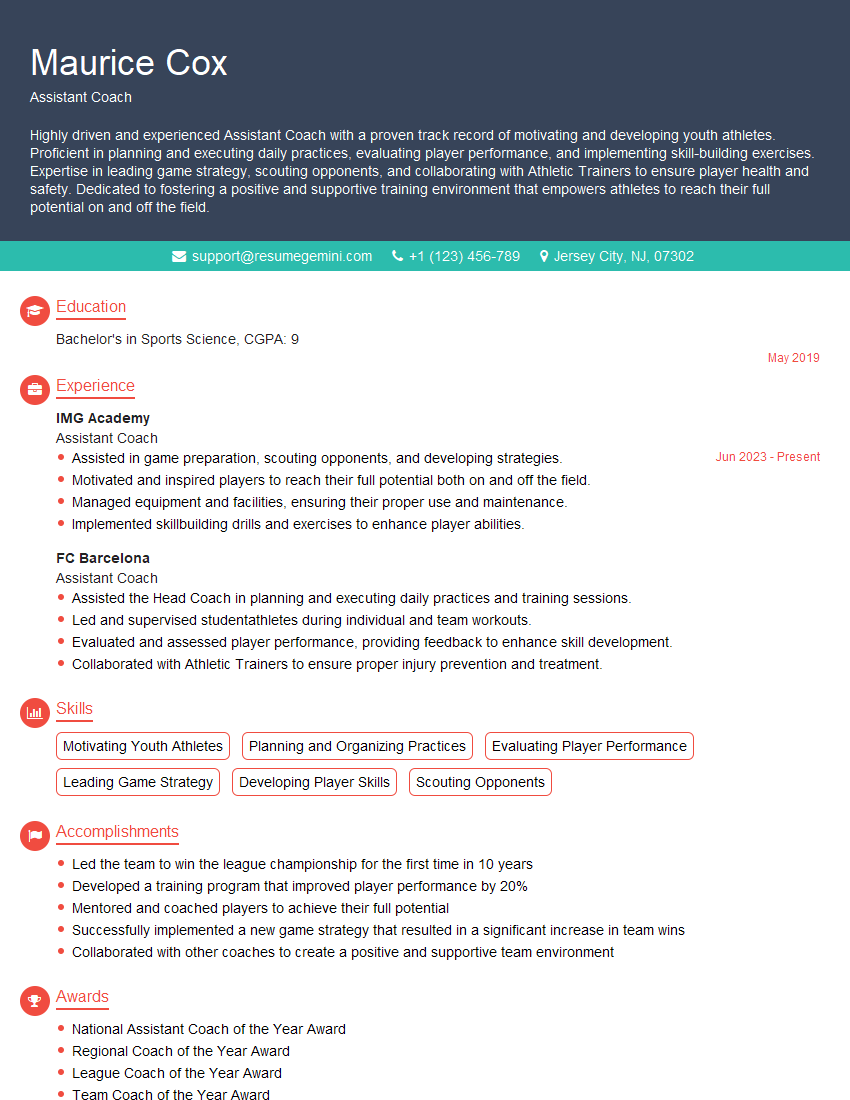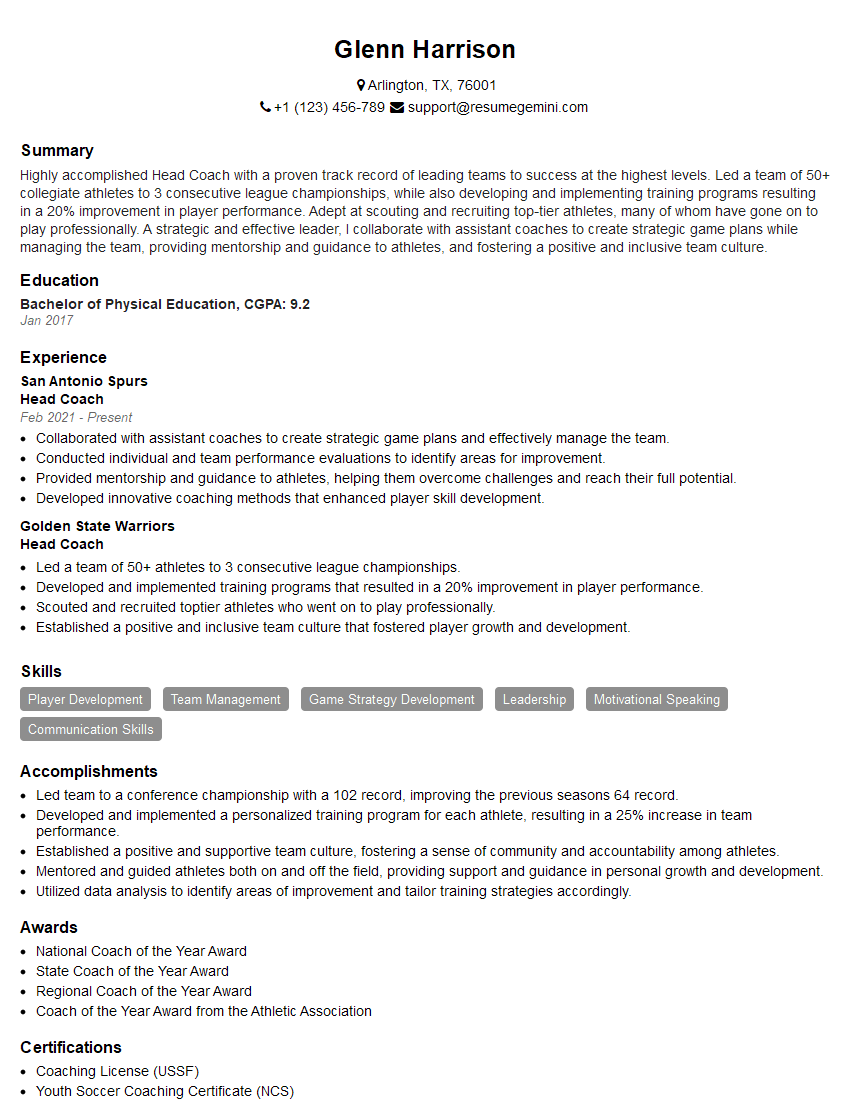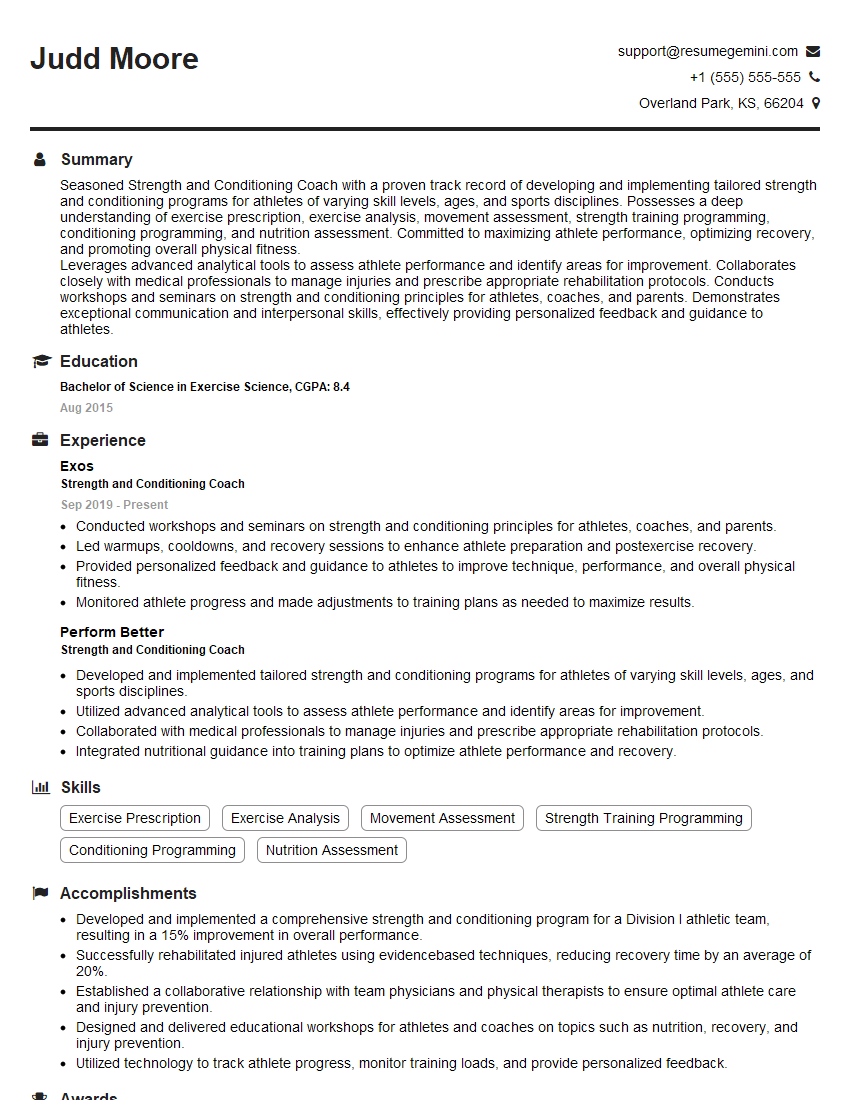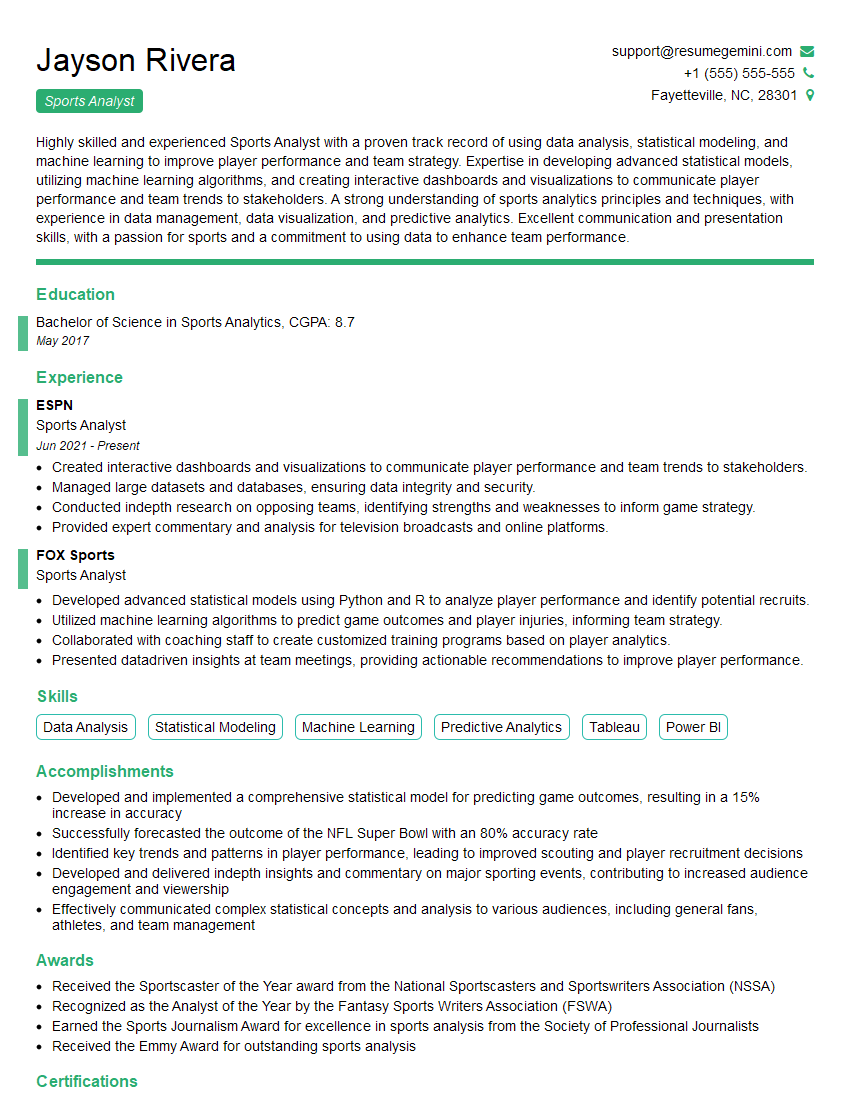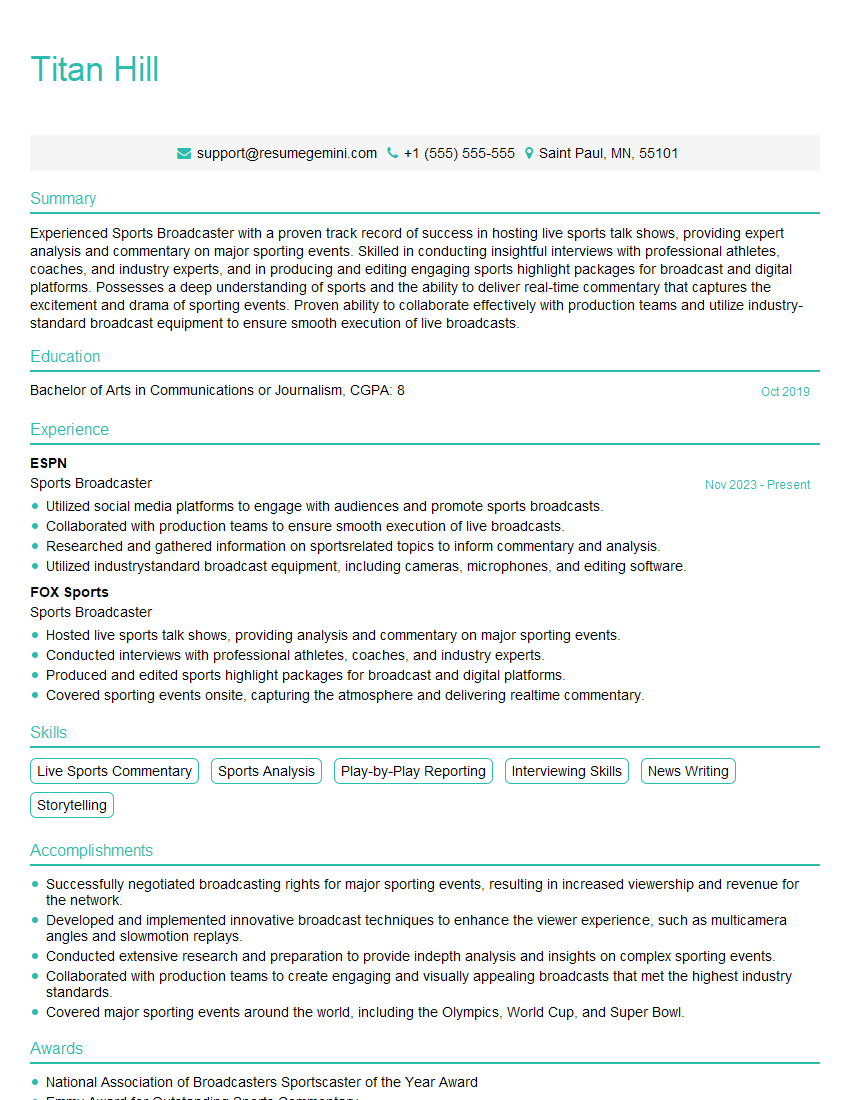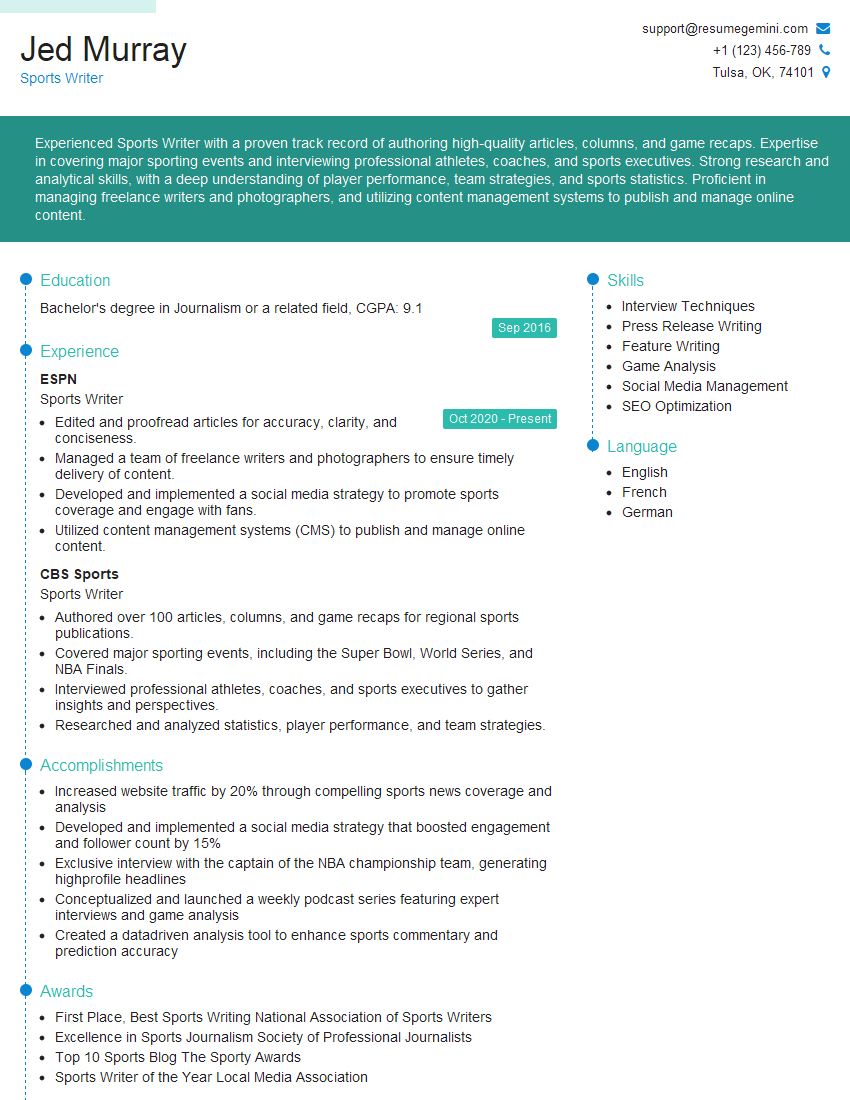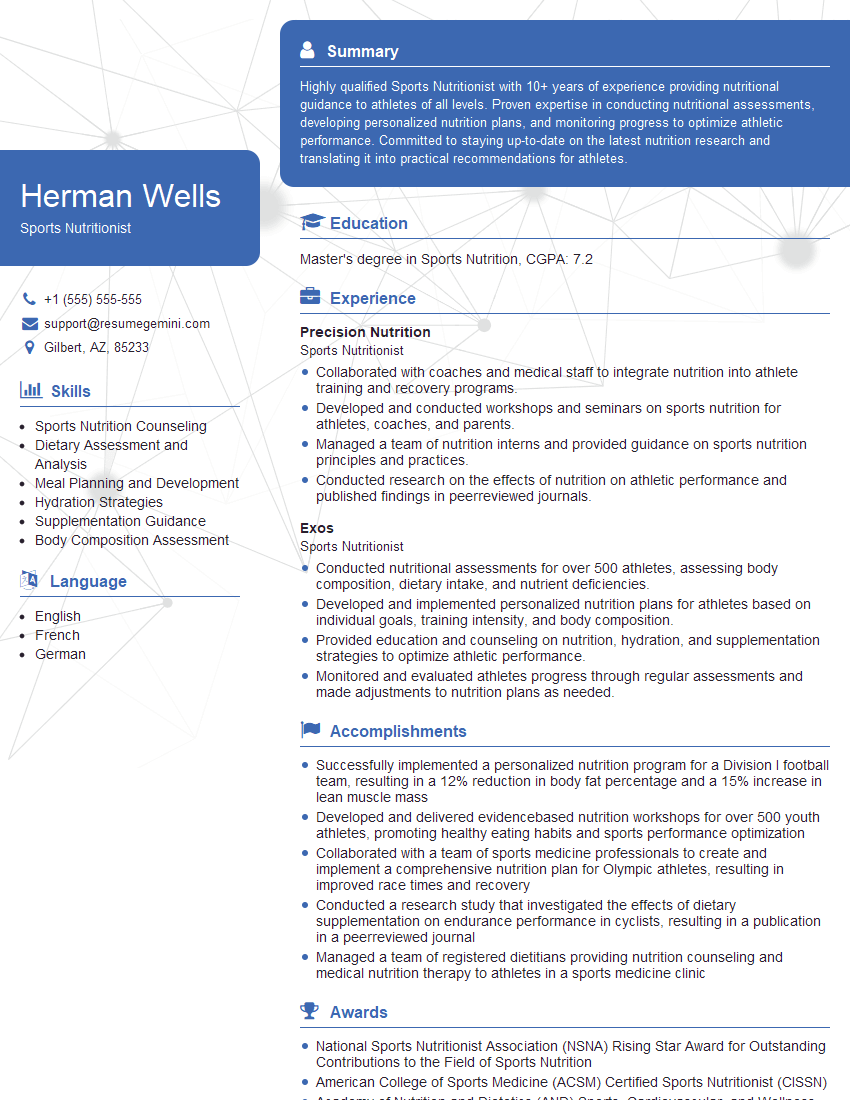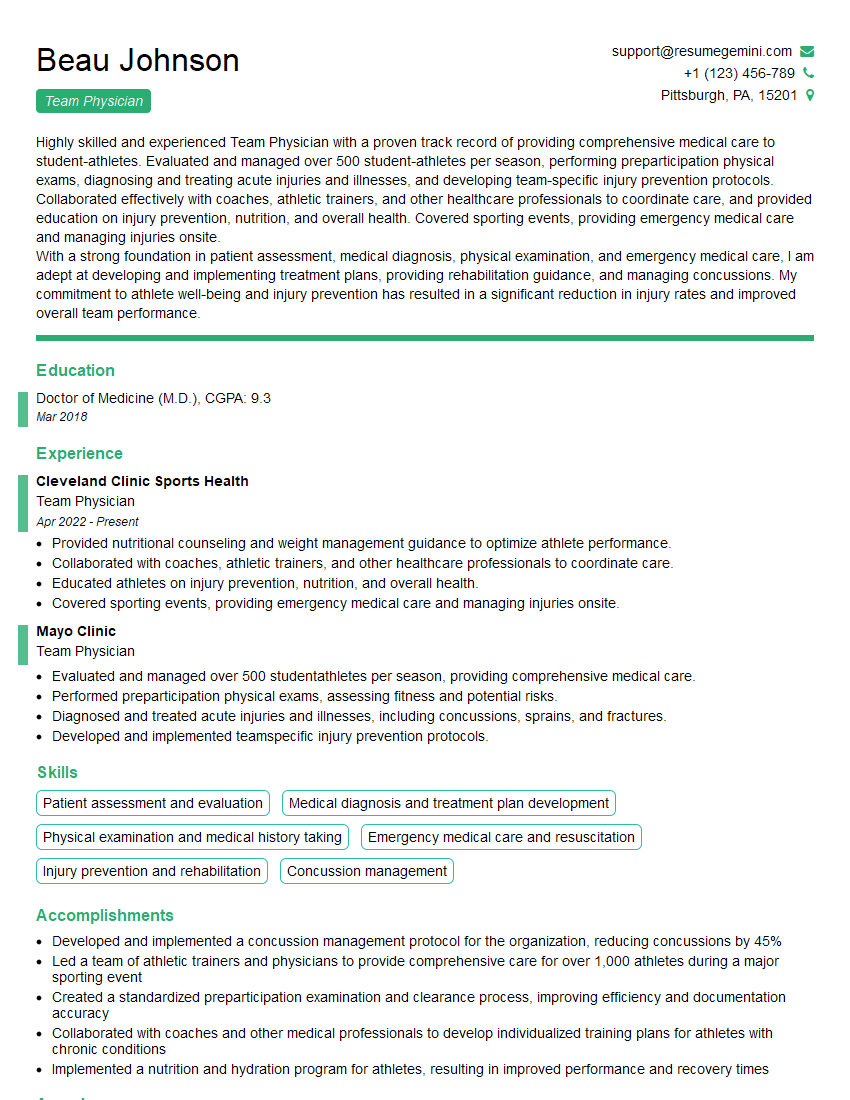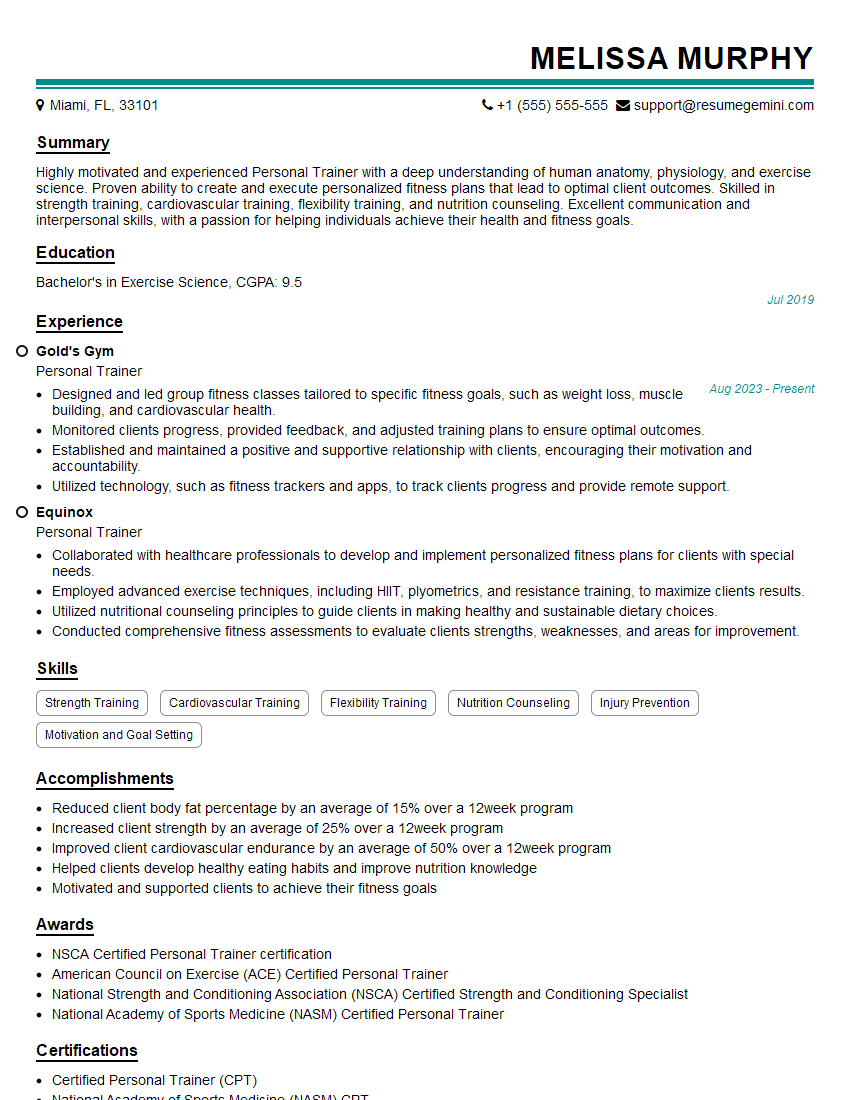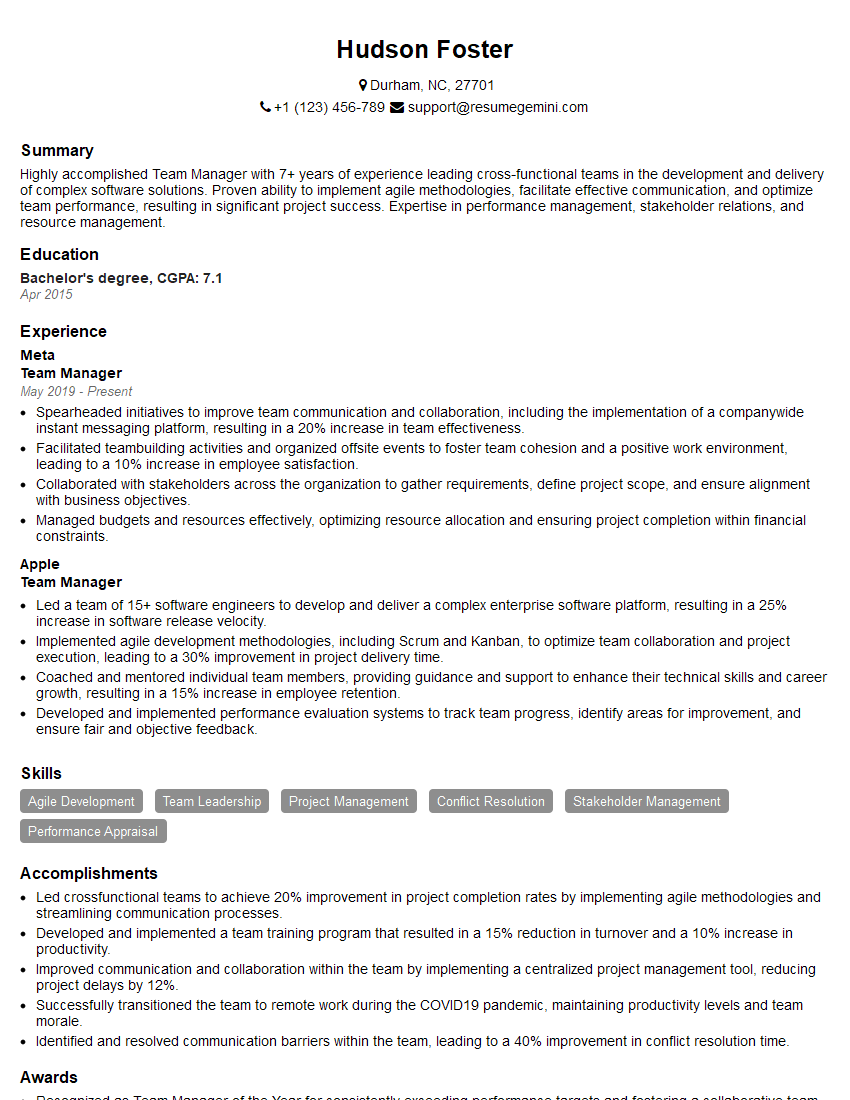Interviews are more than just a Q&A session—they’re a chance to prove your worth. This blog dives into essential Communicating with Players and Coaches interview questions and expert tips to help you align your answers with what hiring managers are looking for. Start preparing to shine!
Questions Asked in Communicating with Players and Coaches Interview
Q 1. Describe your approach to communicating complex strategies to players of varying skill levels.
Communicating complex strategies effectively requires a multi-faceted approach, particularly when dealing with players of diverse skill levels. My strategy centers around breaking down complex information into smaller, digestible chunks. I start with a clear, concise overview of the overarching strategy, using simple language and relatable analogies. For example, if explaining a complex defensive scheme in soccer, I might compare it to a well-oiled machine, where each player represents a crucial cog.
Visual Aids: I utilize diagrams, videos, and even role-playing to visually represent the strategy. This caters to visual learners and makes abstract concepts more concrete.
Differentiated Instruction: For less experienced players, I focus on their specific role within the strategy, emphasizing the key actions they need to perform. More advanced players receive a deeper understanding of the overall tactical plan and their role within it. I might use drills that are tailored to specific skill levels, gradually increasing the complexity as the players become more proficient.
Repetition and Practice: Consistent repetition through drills, scrimmages, and game situations helps reinforce the strategy and allows players to internalize it. Regular quizzes or quick tests can identify knowledge gaps and reinforce learning.
Open Communication: I create a safe space for questions and encourage players to express any confusion or difficulties they experience. This ensures that no player feels left behind.
Q 2. How do you tailor your communication style to individual player personalities and learning preferences?
Understanding individual player personalities and learning preferences is vital for effective communication. I adapt my approach using a combination of observation and direct interaction. I try to understand if a player is a visual, auditory, or kinesthetic learner. This guides my choice of communication methods.
Visual Learners: I use diagrams, charts, and videos.
Auditory Learners: I provide clear, concise verbal explanations, emphasizing key instructions.
Kinesthetic Learners: I incorporate hands-on activities, drills, and practical demonstrations.
Furthermore, I observe players’ reactions and body language to gauge their understanding and adjust my communication accordingly. For example, if a player seems hesitant or confused, I might simplify the explanation or use a different approach. If a player is highly competitive, I might use motivational language and set challenging goals; for a more introverted player, a calmer, more supportive approach may be more effective. I actively seek feedback to understand their preferences and communication styles. This personalization leads to higher retention and understanding.
Q 3. Explain a time you had to address a conflict between players. What was your approach and outcome?
During a high-stakes tournament, two key players clashed due to a miscommunication on the field. One felt the other hadn’t supported them adequately, leading to a frustrated outburst. My approach was to address the situation privately and separately with each player.
Active Listening: I listened attentively to both players without interrupting, allowing them to express their feelings and perspectives. This ensured they felt heard and understood.
Empathy and Validation: I acknowledged the validity of their feelings, emphasizing that such misunderstandings can occur in high-pressure situations. I validated their emotions without condoning the outburst.
Identifying the Root Cause: Together, we identified the root cause of the conflict—a lack of clear communication on the field regarding their roles. I helped them see the situation from the other’s perspective.
Joint Problem-Solving: We collaboratively developed solutions, focusing on better communication strategies on the field, such as pre-game discussions about specific roles and clear verbal cues during the game. This fostered ownership and mutual responsibility for improvement.
The outcome was positive. Both players apologized, demonstrating a greater understanding and respect for each other. The improved communication led to enhanced team performance in subsequent matches.
Q 4. How do you provide constructive feedback to players without undermining their confidence?
Providing constructive feedback is crucial for player development, but it needs to be delivered delicately to protect their confidence. My approach focuses on the ‘feedback sandwich’: positive reinforcement, constructive criticism, and more positive reinforcement.
Start with the Positive: I always begin by highlighting a player’s strengths and achievements, acknowledging their efforts and progress. This sets a positive tone for the conversation.
Focus on Specific Behaviors: I avoid general or vague criticism. Instead, I focus on specific behaviors or actions, using observable examples. For instance, instead of saying ‘you’re not playing well,’ I might say ‘in the last game, your passing accuracy decreased in the second half. Let’s work on improving your footwork and pre-pass positioning.’
Offer Solutions and Suggestions: I don’t just point out weaknesses; I provide concrete suggestions and strategies for improvement. I might demonstrate drills or offer personalized coaching to address the areas needing improvement.
End on a Positive Note: I conclude by reiterating their strengths and expressing confidence in their ability to improve. This reinforces their self-belief and motivates them to work on the areas for development.
This approach ensures that feedback is received constructively, leading to improved performance without damaging the player’s morale.
Q 5. How do you handle criticism from coaches or superiors?
Handling criticism professionally involves a combination of active listening, thoughtful reflection, and assertive communication. I view criticism as an opportunity for growth and improvement, both personally and professionally.
Active Listening: I listen carefully to the feedback, asking clarifying questions to ensure a complete understanding of the concerns.
Self-Reflection: I take time to reflect on the criticism, identifying areas where I could improve. I consider whether the criticism is valid and constructive.
Seeking Clarification: If I feel the criticism is unclear or unfair, I seek clarification and discuss the concerns with the coach or superior. I aim for a constructive dialogue, rather than a defensive reaction.
Implementing Improvements: I actively work on implementing improvements based on the constructive criticism received. I demonstrate my commitment to growth by actively making changes.
Communicating Progress: I update the coach or superior on the progress I’ve made in addressing the concerns, demonstrating accountability and responsibility.
By approaching criticism as an opportunity for growth, I’ve transformed difficult feedback into invaluable learning experiences.
Q 6. Describe your experience in motivating a team during a losing streak.
Motivating a team during a losing streak requires a delicate balance of empathy, encouragement, and strategic adjustments. During a particularly challenging period, our team faced a five-game losing streak. My approach was multi-pronged.
Acknowledge the Struggle: I began by acknowledging the team’s frustration and disappointment. Creating a space to openly express those feelings without judgment was crucial.
Focus on the Positives: Instead of dwelling on the losses, we reviewed game footage, identifying small victories and areas of strength. This helped to maintain morale and focus on progress, no matter how small.
Adjust the Strategy: Based on analysis, we made adjustments to our training regimen and game strategies, addressing specific weaknesses exposed during the losing streak. This demonstrated that we were actively working towards solutions.
Strengthen Team Cohesion: I organized team-building activities outside of practice to foster camaraderie and build trust. These activities helped strengthen the team’s bond and foster a supportive atmosphere.
Reframe the Mindset: We worked on shifting the team’s mindset from a focus on outcomes to a focus on effort and improvement. This ensured the players were motivated by their progress, rather than solely on wins and losses.
The result? While the wins didn’t come overnight, we gradually started seeing improvements in our performance. The losing streak became a learning experience, and the team emerged stronger and more resilient.
Q 7. How do you effectively communicate team goals and expectations?
Effectively communicating team goals and expectations is paramount for team success. I use a combination of methods to ensure everyone is on the same page.
Clearly Defined Goals: I start by setting SMART goals (Specific, Measurable, Achievable, Relevant, Time-bound). These goals are collaboratively developed, ensuring players understand the ‘why’ behind each objective.
Visual Representation: I use visual aids, such as a whiteboard or a shared document, to display the goals and milestones. This provides a constant visual reminder of our objectives.
Open Communication: I create a culture of open communication, where players can freely discuss their concerns, questions, or suggestions regarding the goals. Regular team meetings, both formal and informal, facilitate this discussion.
Individual Roles and Responsibilities: I clearly outline the individual roles and responsibilities each player has in achieving the team goals. This ensures that each player understands their contribution and how it aligns with the overall objectives.
Regular Feedback and Assessment: I provide regular feedback on individual and team progress towards the goals. This allows for adjustments and ensures that everyone stays motivated and on track.
By clearly communicating and consistently reinforcing the team goals and expectations, I create a cohesive and focused team environment that is more likely to achieve its objectives.
Q 8. How do you use technology to enhance communication with players and coaches?
Technology is crucial for efficient communication in today’s sports world. I leverage several platforms to enhance interaction with players and coaches. For instance, I use team management apps like TeamSnap or SportyHQ to send out schedules, announcements, and important updates directly to players’ phones. This ensures everyone is informed in a timely manner, regardless of their location. Video conferencing tools like Zoom or Google Meet facilitate remote coaching sessions, strategy reviews, and individual player feedback, particularly useful during off-season training or for players with scheduling constraints. Finally, I often incorporate learning management systems (LMS) like Moodle to share training videos, instructional materials, and performance analysis data. This ensures consistent and accessible learning opportunities for all team members.
For example, after a game, I’ll upload a short video highlighting key plays and areas for improvement using a platform like Hudl, ensuring players receive targeted feedback promptly. This personalized approach, coupled with readily accessible information, improves understanding and facilitates quicker progress.
Q 9. How do you ensure clear and consistent communication across all team members?
Clear and consistent communication requires a multi-pronged approach. Firstly, establishing clear communication protocols is key. This includes defining who is responsible for what information and establishing preferred communication channels for different situations (e.g., emergencies via phone, tactical discussions in team meetings, routine updates via email). Secondly, consistent messaging is vital. All information disseminated should be accurate, unambiguous, and reflect the overall team goals and strategy. Regular team meetings, both formal and informal, provide a platform for open dialogue, clarifying any ambiguities and ensuring everyone is on the same page. Finally, actively seeking feedback from players and coaches through surveys or informal check-ins helps to identify any communication gaps and allows for adjustments as needed.
For instance, if a change in training schedule is announced, I ensure the message is conveyed across all channels (team app, email, and possibly a verbal announcement during a meeting) to minimize confusion. Following up to confirm understanding is equally critical.
Q 10. Describe your experience using different communication channels (e.g., meetings, emails, individual conversations).
My experience spans various communication channels, each with its strengths and weaknesses. Team meetings are crucial for collective decision-making, strategy discussions, and fostering team cohesion. Emails are efficient for transmitting non-urgent information, schedules, and documentation. Individual conversations are invaluable for providing personalized feedback, addressing individual concerns, and building rapport. I tailor my communication approach based on the message and the audience. For instance, I prefer face-to-face conversations to address sensitive performance issues to read body language and have a more nuanced exchange. Emails are suitable for sending reminders or scheduling confirmations. Team meetings are most effective for disseminating broader strategies and goals.
I have found that combining various channels is the most effective method. For example, I might announce a strategic change in a team meeting, then follow up with an email summarizing the key points and action items. Later, I might schedule individual conversations to address specific questions or concerns individual players may have.
Q 11. How do you manage communication during high-pressure situations (e.g., games, competitions)?
High-pressure situations demand concise, clear, and immediate communication. During games or competitions, I prioritize short, specific instructions delivered calmly and confidently. Nonverbal cues like body language and facial expressions are equally crucial. I use pre-determined signals and code words to relay tactical changes quickly and efficiently, minimizing verbal distractions during the heat of the moment. Post-game analysis is critical. I dedicate time immediately following the game or competition for a brief debrief to address immediate issues and gather player feedback. A more comprehensive review then takes place later to avoid overwhelming the players at the height of emotion.
For example, during a timeout, instead of lengthy explanations, I might simply say, “Switch to zone defense” and use a hand signal to visually reinforce the instruction. This method prioritizes clarity and effectiveness during a high-stress situation.
Q 12. How do you deal with a player who consistently ignores your instructions?
Addressing a player who consistently ignores instructions requires a systematic approach. I begin by privately addressing the player, understanding the reason for their non-compliance. It could range from a lack of understanding, a skill deficit, personal issues, or a lack of motivation. I use active listening to understand their perspective and then explain clearly the importance of following instructions for team success and player safety. If the behavior persists, I’ll involve the coach to reinforce expectations and potentially implement disciplinary measures. In more severe cases, I might collaborate with a sports psychologist to help the player address any underlying issues hindering their compliance.
For example, I’d initially schedule a one-on-one session with the player, asking open-ended questions like, “Can you tell me more about why you didn’t follow the instructions during the last drill?” This approach prioritizes understanding before resorting to disciplinary actions.
Q 13. How do you foster open and honest communication within the team?
Fostering open and honest communication requires trust and mutual respect. I create a safe environment where players and coaches feel comfortable expressing their opinions, concerns, and ideas without fear of judgment. Regular team meetings and informal interactions allow for open dialogue and feedback. I actively listen to players’ concerns and acknowledge their perspectives, even if I don’t necessarily agree with them. Anonymity-ensuring tools like suggestion boxes or anonymous feedback forms can also encourage honest input. Encouraging constructive criticism, providing regular updates, celebrating successes, and providing support during setbacks further contribute to establishing a culture of transparency.
For example, we regularly have informal “team chats” outside of formal practice sessions to share experiences and address any issues that arise.
Q 14. How do you ensure your communication is both effective and respectful?
Effective and respectful communication is achieved by prioritizing clarity, empathy, and consideration. I use clear and concise language, avoiding jargon or technical terms that players might not understand. I actively listen and seek clarification to ensure my message is received accurately. I am mindful of my tone and body language, ensuring they convey respect and support. When delivering constructive criticism, I focus on specific behaviors and their impact, rather than attacking the player’s character. I also use positive reinforcement to motivate and encourage positive behavior. Finally, regular feedback helps ensure my communication remains effective and meets the team’s needs.
For instance, instead of saying “You played terribly,” I might say, “Your passing accuracy was lower than usual today. Let’s work on some drills to improve this aspect of your game.” This approach is constructive and avoids negativity.
Q 15. How do you facilitate communication between players and their parents/guardians?
Facilitating communication between players and their parents/guardians requires a proactive and multi-faceted approach. It’s about creating a transparent and open environment where everyone feels comfortable sharing information and concerns.
- Regular Communication Channels: I establish clear channels for communication, such as regular team emails, a dedicated online platform (like a team app or website), and scheduled parent-coach meetings. This ensures consistency and prevents important information from getting lost.
- Individualized Communication: I recognize that every family is unique. I prioritize one-on-one communication when needed, addressing individual concerns and offering tailored support. For instance, I might schedule a phone call with a parent who’s expressed anxiety about their child’s playing time.
- Positive Language and Feedback: I focus on using positive language and providing constructive feedback to both players and parents. Highlighting effort, improvement, and teamwork fosters a positive and collaborative atmosphere.
- Addressing Concerns Promptly: I address any concerns or complaints promptly and efficiently. Delaying responses can lead to misunderstandings and escalate minor issues. I aim to resolve conflicts fairly and transparently, involving all relevant parties as needed.
For example, in one situation, a parent was concerned about their child’s lack of playing time. By scheduling a meeting, I explained the strategic decisions behind playing time, outlining the child’s strengths and areas for improvement. This open dialogue helped the parent understand the process and fostered a stronger parent-coach relationship.
Career Expert Tips:
- Ace those interviews! Prepare effectively by reviewing the Top 50 Most Common Interview Questions on ResumeGemini.
- Navigate your job search with confidence! Explore a wide range of Career Tips on ResumeGemini. Learn about common challenges and recommendations to overcome them.
- Craft the perfect resume! Master the Art of Resume Writing with ResumeGemini’s guide. Showcase your unique qualifications and achievements effectively.
- Don’t miss out on holiday savings! Build your dream resume with ResumeGemini’s ATS optimized templates.
Q 16. How do you handle disagreements with coaches or other staff members?
Disagreements with coaches or staff are inevitable, but handling them professionally is crucial for a healthy team environment. My approach focuses on constructive dialogue and collaboration.
- Private and Respectful Dialogue: I believe in addressing disagreements privately and respectfully. I strive to create a space where everyone feels comfortable expressing their opinions without fear of judgment. This often involves one-on-one conversations.
- Active Listening and Empathy: I practice active listening, making sure to understand the perspectives of all parties involved before offering my own opinion. Empathy is key to finding common ground and fostering understanding.
- Focus on Shared Goals: I remind everyone of the shared goals of the team – player development, success on the field, and creating a positive team environment. This helps to refocus the conversation on what matters most.
- Compromise and Collaboration: Finding common ground and compromising is essential. I encourage collaboration and finding solutions that satisfy all parties involved, even if it means making adjustments to plans.
- Seeking Mediation if Necessary: If the disagreement cannot be resolved through direct dialogue, I’m prepared to seek mediation from a higher authority within the organization.
For instance, a disagreement arose between the head coach and assistant coach regarding training methods. I facilitated a meeting where they could openly discuss their concerns, ultimately finding a compromise that incorporated elements from both approaches. The key was focusing on the players’ overall development.
Q 17. Describe your experience building relationships with players.
Building strong relationships with players is fundamental to my approach. It’s about creating a supportive and trusting environment where players feel valued and respected.
- Individualized Attention: I get to know each player individually, understanding their strengths, weaknesses, motivations, and aspirations. This involves regular check-ins, both on and off the field.
- Positive and Encouraging: I maintain a positive and encouraging attitude, creating a safe space where players feel comfortable making mistakes and learning from them. I praise effort and progress, even in the face of setbacks.
- Active Listening and Empathy: I practice active listening, showing players that I care about their thoughts and feelings. Empathy allows me to understand their unique perspectives and respond appropriately.
- Consistency and Trustworthiness: Consistency and trustworthiness are paramount. Players need to know that they can rely on me to be fair, honest, and supportive, regardless of their performance on the field.
- Open Communication: I maintain open communication with players, encouraging them to share their concerns, ideas, and feedback.
One example: I noticed a player was struggling with confidence. Through regular conversations and targeted support, I helped them identify their strengths and develop strategies to overcome their challenges. The result was a significant boost in their self-esteem and performance.
Q 18. How do you use positive reinforcement to motivate players?
Positive reinforcement is a cornerstone of motivation. It’s about recognizing and rewarding positive behaviors and effort, rather than focusing solely on outcomes.
- Specific and Timely Praise: I provide specific and timely praise, highlighting what the player did well and why it was effective. Generic praise can be less impactful.
- Public and Private Recognition: I recognize players both publicly (e.g., team meetings, awards) and privately (e.g., individual conversations), tailoring my approach to each player’s personality.
- Focus on Effort and Improvement: I emphasize effort and improvement, even if the results aren’t immediately visible. This fosters a growth mindset and encourages persistence.
- Non-Material Rewards: I use a variety of rewards, both material (e.g., small gifts, certificates) and non-material (e.g., extra playing time, leadership roles). Non-material rewards often prove more effective in the long term.
- Celebrate Successes, Big and Small: I celebrate both individual and team successes, creating a positive and supportive team culture.
For example, after a particularly challenging practice, I praised a player for their perseverance and positive attitude, highlighting their efforts even though they made some mistakes. This approach reinforced their hard work and motivated them to continue striving for improvement.
Q 19. How do you identify and address communication barriers within the team?
Identifying and addressing communication barriers within a team requires careful observation and proactive strategies.
- Observe Team Dynamics: I carefully observe team dynamics, paying attention to nonverbal cues, communication patterns, and any signs of conflict or exclusion.
- Surveys and Feedback: I use surveys and feedback sessions to gather information directly from players and coaches. This can reveal underlying issues or communication breakdowns.
- Address Language Barriers: If language barriers exist, I ensure appropriate translation services are available or work with bilingual individuals to facilitate clear communication.
- Promote Inclusive Communication Styles: I actively promote inclusive communication styles that value diverse perspectives and ensure that all team members feel heard and understood.
- Establish Clear Communication Protocols: Clear communication protocols, such as designated channels for information dissemination and feedback, help reduce ambiguity and misunderstandings.
In one instance, I noticed a significant communication gap between the veteran players and newer players. By implementing team-building activities and establishing mentorship programs, I fostered a more inclusive communication environment, leading to improved team cohesion and performance.
Q 20. Explain your experience in providing feedback to coaches.
Providing feedback to coaches requires tact, diplomacy, and a focus on constructive criticism. My approach emphasizes collaboration and mutual respect.
- Choose the Right Time and Place: I schedule a private meeting to discuss feedback, ensuring a comfortable and relaxed environment where the coach feels safe to receive feedback.
- Focus on Specific Examples: I use specific examples to illustrate my points, avoiding vague or generalized statements. This makes the feedback more concrete and actionable.
- Balance Positive and Constructive Feedback: I always balance positive feedback with constructive criticism, starting with the positive aspects and then gently addressing areas for improvement.
- Offer Solutions: I don’t just point out problems; I offer potential solutions or strategies that the coach can implement to address the issues.
- Focus on Shared Goals: I consistently remind the coach of the team’s shared goals, framing feedback in a way that aligns with the overall objectives.
For example, I once provided feedback to a coach about their communication style during practices. Instead of simply stating they were too critical, I offered specific examples and suggested alternative approaches that would foster a more positive and supportive environment for the players. The coach was receptive, and we collaborated on implementing these changes.
Q 21. How do you maintain effective communication during periods of significant change or upheaval?
Maintaining effective communication during significant change or upheaval requires a proactive and transparent approach.
- Proactive Communication: I communicate changes promptly and clearly, addressing potential concerns and uncertainties before they escalate.
- Open Dialogue and Transparency: I foster open dialogue and transparency, ensuring players and coaches have access to the information they need to understand the changes and their implications.
- Empathy and Support: I demonstrate empathy and understanding, acknowledging that change can be stressful and difficult. I offer support and resources to help individuals cope with the transition.
- Flexibility and Adaptability: I remain flexible and adaptable, modifying communication strategies as needed to accommodate the changing circumstances.
- Regular Check-Ins and Feedback: I schedule regular check-ins and feedback sessions to monitor the effectiveness of communication and address any emerging challenges.
For example, when a new coach was hired, I ensured that both the players and the previous coach understood the transition process. I facilitated meetings, answered questions, and provided updates to prevent misinformation and foster a smooth transition. This transparency was key to minimizing disruption and maintaining a positive team environment.
Q 22. How do you balance individual player needs with team goals during communication?
Balancing individual player needs with team goals is a crucial aspect of effective communication. It’s about finding the sweet spot between fostering individual growth and ensuring collective success. This involves a multifaceted approach.
- Individualized Feedback: I start by understanding each player’s strengths, weaknesses, and aspirations. This informs how I tailor my feedback, focusing not just on performance metrics but also on personal development goals. For example, a young player might need more encouragement and development-focused feedback, while a veteran might benefit from more strategic and nuanced conversations.
- Transparent Communication: Open and honest communication is key. I ensure players understand the team’s overall objectives and how their individual roles contribute to that success. I explain the rationale behind tactical decisions and provide opportunities for them to voice their concerns or suggestions.
- Collaborative Goal Setting: I encourage players to participate in setting both individual and team goals. This fosters a sense of ownership and commitment. For instance, a player might set a personal goal of improving their shooting percentage while the team aims to win the championship. We then discuss how his improved shooting directly impacts team performance.
- Empathy and Understanding: Recognizing that each player is an individual with unique circumstances, motivations, and emotional states is essential. Sometimes, a player’s performance might be impacted by factors unrelated to the game. Showing empathy and actively listening can create a supportive environment.
Q 23. How do you use non-verbal communication effectively?
Non-verbal communication is incredibly powerful, often conveying more than words alone. It’s essential to use it consciously and effectively.
- Body Language: Maintaining positive and open body language – such as good posture, appropriate eye contact, and relaxed but attentive demeanor – shows engagement and respect. Conversely, crossing arms or avoiding eye contact can be interpreted negatively.
- Facial Expressions: Your facial expressions directly impact how your message is received. A smile conveys encouragement, while a frown can signal disapproval. I aim to match my facial expression with the tone of my communication, ensuring consistency.
- Proxemics: The physical distance between you and the person you’re communicating with also matters. Maintaining an appropriate distance shows respect and avoids making the other person feel uncomfortable. In high-pressure situations, I might adjust my proximity to provide support or reassurance.
- Gestures: I use gestures sparingly and purposefully to enhance my verbal message, rather than distracting from it. For example, a small nod during a conversation signals agreement or understanding.
For example, during a timeout, a firm, yet encouraging hand gesture might convey a sense of urgency and focus to a player without interrupting the flow of the verbal strategy discussion.
Q 24. How do you adapt your communication style to different cultural backgrounds?
Adapting communication style across cultures requires sensitivity and awareness. It involves understanding and respecting cultural norms, values, and communication styles.
- Cultural Research: Before interacting with individuals from diverse backgrounds, I research common cultural nuances in communication. For example, some cultures value direct communication, while others prefer indirect, more nuanced approaches.
- Active Listening: Paying close attention to both verbal and non-verbal cues is critical. This allows me to identify potential misunderstandings or misinterpretations based on cultural differences.
- Language: If possible, I try to communicate in the player’s native language, or at least ensure a translator is present. Even small gestures of linguistic consideration, like using their preferred name, show respect.
- Patience and Empathy: Communicating across cultures often requires more patience and understanding. Differences in communication styles don’t necessarily indicate disinterest or disrespect; they might simply be cultural norms.
For example, in a team with players from several countries, I might adjust my communication to match their preferred style. If a player prefers a more reserved and indirect approach, I would avoid being overly direct or confrontational. Instead I’d employ more subtle communication tactics.
Q 25. How do you handle media inquiries related to the team or individual players?
Handling media inquiries requires a strategic and consistent approach that protects both the team’s reputation and the privacy of individual players.
- Preparedness: I prepare key messages in advance, focusing on positive team news and progress. I also anticipate potential challenging questions and prepare thoughtful responses.
- Honesty and Transparency: While respecting confidentiality, I strive to be honest and transparent in my communication. Avoiding speculation and offering clear, concise answers builds trust.
- Media Training: I work with players and coaches to prepare them for media interviews, helping them articulate their thoughts effectively and avoid potential pitfalls. I might role-play different scenarios to help them feel more confident.
- Strategic Messaging: I manage media relations to control the narrative, ensuring the focus remains on team achievements and progress rather than controversies or internal conflicts.
For example, if a player makes a mistake during a game, I might address the media by highlighting the player’s strengths and emphasizing the team’s overall performance, while acknowledging the mistake as a learning opportunity. This balances accountability with support and minimizes negativity.
Q 26. Describe a time you had to deliver difficult news to a player or coach.
I once had to inform a promising young player that he wasn’t going to make the starting lineup. This was difficult because he had worked incredibly hard and had a strong desire to start.
My approach was to schedule a private meeting with him. I started by acknowledging his hard work and dedication, emphasizing his value to the team. Then, I clearly explained my decision, providing specific, constructive feedback based on his performance and the needs of the team. I emphasized that my decision wasn’t a reflection of his potential but rather a strategic choice based on the team’s current dynamics. I offered a plan for how he could improve and increase his chances of getting more playing time, providing tangible steps he could take. I made sure to listen to his concerns and address them openly and honestly. The conversation was challenging, but maintaining open communication and providing clear direction allowed him to understand and accept the situation.
Q 27. How do you ensure that communication is timely and relevant?
Timely and relevant communication is essential for maintaining a well-functioning team. Delays or irrelevant information can be detrimental to morale and performance.
- Regular Communication Schedules: I establish clear and consistent communication channels and schedules. This might involve regular team meetings, individual check-ins, and updates through various communication platforms.
- Prioritization: I prioritize information based on urgency and relevance to the team. I use appropriate communication channels to ensure the right information reaches the right people at the right time.
- Feedback Mechanisms: I create mechanisms for players and coaches to provide feedback, ensuring that their concerns are addressed promptly and effectively. This could involve surveys, feedback sessions, or simply encouraging open communication.
- Technology: Utilize technology, such as team communication apps or online platforms, to facilitate efficient and timely dissemination of information.
For example, instead of waiting until the end of the week to provide feedback on individual performances, I use short, regular check-ins after practices and games to address immediate needs and ensure timely feedback.
Q 28. How do you use data and analytics to inform your communication strategies?
Data and analytics play a significant role in informing my communication strategies. By using data-driven insights, I can tailor my messages to be more precise, impactful, and effective.
- Performance Metrics: I use performance data, such as individual player statistics, team performance metrics, and opponent scouting reports, to provide objective feedback and identify areas for improvement.
- Player Tracking: Advanced analytics, such as player tracking data, allows me to identify patterns and trends in players’ movement and behavior, allowing for more targeted coaching and communication. For example, if a player is struggling with decision-making in certain game situations, I can use this data to analyze their tendencies and suggest specific strategies to improve.
- Visualizations: Data visualizations, such as charts and graphs, can communicate complex information more effectively and make data more accessible for players and coaches who may not be statistically inclined.
- Communication Effectiveness: I can even track the effectiveness of my communication strategies, by analyzing player responses and performance changes following communication interventions. This allows me to refine my approach.
For example, I might use shooting charts to demonstrate a player’s shooting efficiency from different areas on the court, enhancing my verbal feedback about improving their shooting technique.
Key Topics to Learn for Communicating with Players and Coaches Interview
- Active Listening & Empathetic Communication: Understanding nonverbal cues, tailoring communication styles to individual personalities (players vs. coaches), and effectively addressing diverse communication needs within a team environment.
- Constructive Feedback & Motivation: Delivering performance feedback that is both specific and encouraging, fostering a growth mindset, and using positive reinforcement techniques to boost player morale and performance. Practical application: Developing a framework for delivering both positive and critical feedback in a way that motivates improvement.
- Conflict Resolution & Team Dynamics: Identifying and addressing interpersonal conflicts within the team, mediating disagreements effectively, and fostering a positive and collaborative team environment. Practical application: Role-playing conflict resolution scenarios to practice effective communication strategies.
- Effective Communication Channels: Utilizing appropriate communication channels for different situations (e.g., one-on-one meetings, team huddles, written communication). Understanding the limitations and strengths of different mediums.
- Setting Clear Expectations & Goals: Clearly communicating expectations for performance, behavior, and team goals to both players and coaches. Practical application: Developing a strategy for setting SMART goals (Specific, Measurable, Achievable, Relevant, Time-bound).
- Building Rapport & Trust: Establishing strong relationships built on trust and mutual respect with players and coaches. Understanding the importance of building credibility and demonstrating professionalism.
- Nonverbal Communication: Recognizing and using body language effectively to enhance communication. Understanding how nonverbal cues can impact communication and team dynamics.
Next Steps
Mastering communication with players and coaches is crucial for career advancement in sports. Effective communication skills are highly valued by employers and directly contribute to team success, player development, and a positive work environment. To maximize your job prospects, invest time in creating an ATS-friendly resume that highlights your relevant skills and experience. ResumeGemini is a trusted resource to help you build a professional and impactful resume. We provide examples of resumes tailored to highlight expertise in communicating with players and coaches to help guide you in this process.
Explore more articles
Users Rating of Our Blogs
Share Your Experience
We value your feedback! Please rate our content and share your thoughts (optional).
What Readers Say About Our Blog
good
